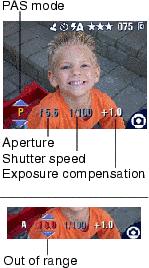Kodak EasyShare DX6440 zoom digital camera — User's Guide
Table of Contents > Taking Pictures > PAS Mode
2 Taking Pictures
PAS Mode

|

|

|

|

|
Use PAS mode when you want ultimate creative control. PAS mode gives you quick access to Program, Aperture priority, and Shutter priority modes. See Selecting Modes and Settings in PAS Mode for directions on how to select the modes and settings in PAS mode. |
||
Program Mode
Use Program mode when you want to manually control exposure compensation (how much light enters the camera). The camera automatically sets the shutter speed and aperture (f-stop) based on the scene lighting.
Aperture Priority Mode
Use Aperture priority mode when you want to manually control aperture and exposure compensation. The camera automatically sets the shutter speed for proper exposure. Aperture priority mode is primarily used to control depth of field (the range of sharpness).
| NOTE: | The aperture setting may be affected when using optical zoom. |
Shutter Priority Mode
Use Shutter priority mode when you want to manually control the shutter speed and exposure compensation. The camera automatically sets the aperture for proper exposure. Shutter priority mode is primarily used to prevent blur when your subject is moving. Use a tripod for shutter speeds slower than 1/60".
Selecting Modes and Settings in PAS Mode

|

|

|

|

|
1.
Turn the Mode dial to PAS.
Liveview turns on and the PAS mode options appear on the camera screen. |
||

|
2.
The PAS mode setting is selected (highlighted in yellow). Move the joystick
 to change the setting: to change the setting:
If an option is marked with red, it is out of range and may cause unacceptable image/print quality. Adjust the setting up or down until it turns white. |
||
|
3.
Move the joystick
 to select the option you wish to change. Then move the joystick to select the option you wish to change. Then move the joystick  to change the setting. See PAS Mode Screen Options for option descriptions. to change the setting. See PAS Mode Screen Options for option descriptions. In each PAS mode, you can change only the options that are highlighted in white. Unavailable options are grey. |
|||
|
4.
Press the Menu button to change other settings. See this Chapter (2) for details.
|
|||
PAS Mode Screen Options
Aperture—also referred to as f-number, controls the size of the lens opening, which determines the depth of field. Smaller aperture settings keep both foreground and background sharp, good for landscapes and well-lit conditions. Larger aperture settings make the subject sharp and background blurry, good for portraits and low-light conditions. The highest and lowest aperture settings may be affected when using optical zoom.
Shutter speed—controls how long the shutter stays open. To prevent camera shake, use a tripod for shutter speeds slower than 1/60 second.
Exposure compensation—controls how much light enters the camera, good for controlling backlit scenes. If the picture is too light, decrease the setting; if it's too dark, increase the setting. See Setting Exposure Compensation for setting exposure compensation in other modes.
Settings Apply Only in PAS Mode
Settings you change while in PAS mode apply only to pictures taken while in PAS mode. For example, if you change the Color Mode to Sepia while in PAS mode, all other still modes (auto, sport, portrait, night, landscape, and close up) retain the default setting of Color.
The settings, including Flash, remain active for PAS mode even when you change modes or turn off the camera. This is the place to set and keep your custom settings.
| IMPORTANT: | Use Reset (Resetting PAS Settings to Defaults) to return PAS mode to the default settings. |
Previous Next